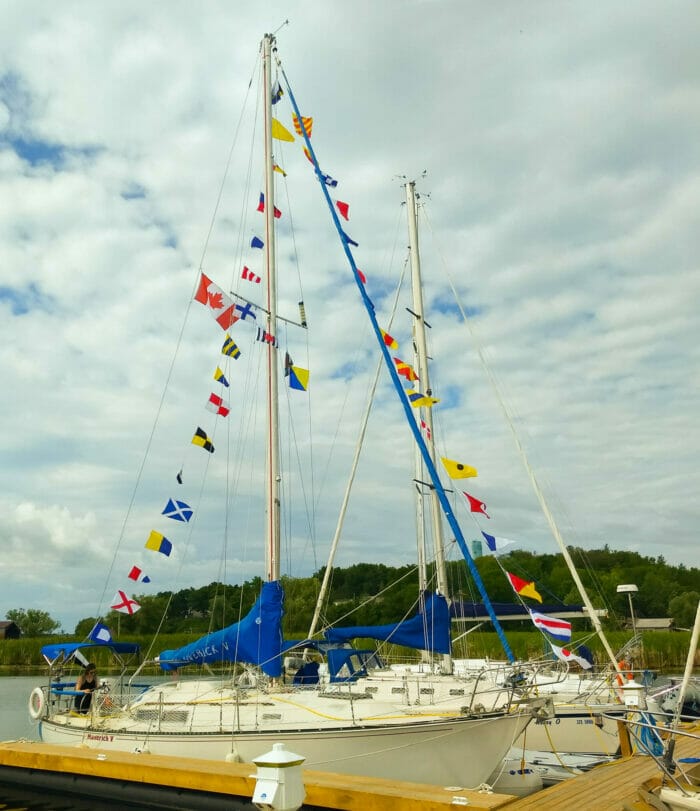
Two years ago, we asked the question: Is it possible to get started in cruising, with a safe and seaworthy boat, for under C$40,000 (US$30,000)?
- In Part 1, we looked at how to analyze our own situation.
- What do we really intend to do with the boat?
- How do we separate our actual needs and must-have features from our whims, and what can we leave out?
- What can we afford to commit upfront to buy and fix up the boat, and what can we afford to burn each year to keep her afloat?
- In Part 2, we put some real money on the table, and traded in the wish list for a C&C 35 Mk.II named Maverick V.
Then we sailed her across Lake Erie, down the Welland Canal, and across Lake Ontario to her new home base in Kingston.
Since then, Maverick V and her crew have been out on Lake Ontario and the St. Lawrence River most weekends, plus one or two evenings a week, during the last couple of sailing seasons.
We’ve now had:
- The latter half of 2020 to get used to sailing her,
- the winter of 2020-21 to do some refitting,
- and the summer of 2021 to see how our upgrades worked out and to finish up some less-urgent tasks.
With pretty much all the parts and materials now purchased, and just a handful of tasks left on the essentials list—plus a handful of surprises that were on nobody’s list—it’s time to check up on the project:
- Are we within budget?
- What did we upgrade?
- What broke?
- Do the kids enjoy it?
- Was the whole effort worthwhile?
The Rig
Boom Rehab
As it turns out, “Sail collapses in a great disorderly heap and then you tackle it like a football player” is not a great way to do mainsail reefing and furling. And the boom, after 45 years of abuse and modification, was, while structurally intact, showing its age cosmetically.
So:
- Off comes all the old hardware,
- Strip the paint from the spar,
- Check all over it for damage,
- Weld up the no-longer-needed screw holes,
- Repaint it.
- Install a cost-reduced version of the AAC Reefing Made Easy system using a pair of Andersen 18ST winches and Lewmar DC clutches.
- Install a set of lazyjacks scaled to fit the 277 sq.ft. mainsail and rigged so that they can be fully collapsed under the original sail cover once the sail ties are on.
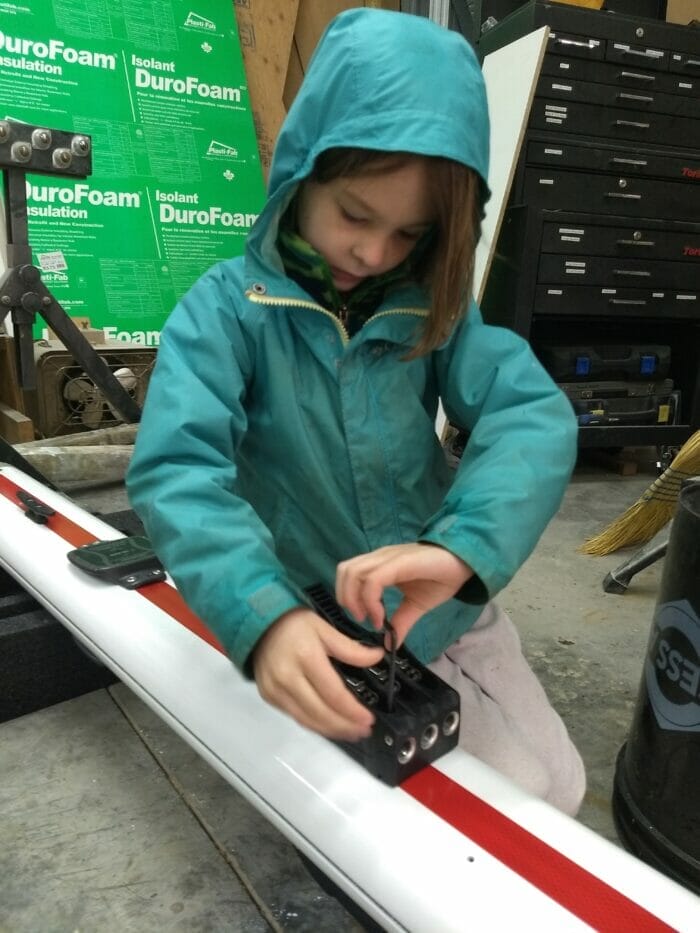
Rigid Vang
It also turns out that dead-headed at the top of the mast topping lifts with 1:1 purchase are worse than useless when the loaded boom is heavier than your crew can lift, so in the interests of safety, we bought and installed a Garhauer sprung rigid vang.
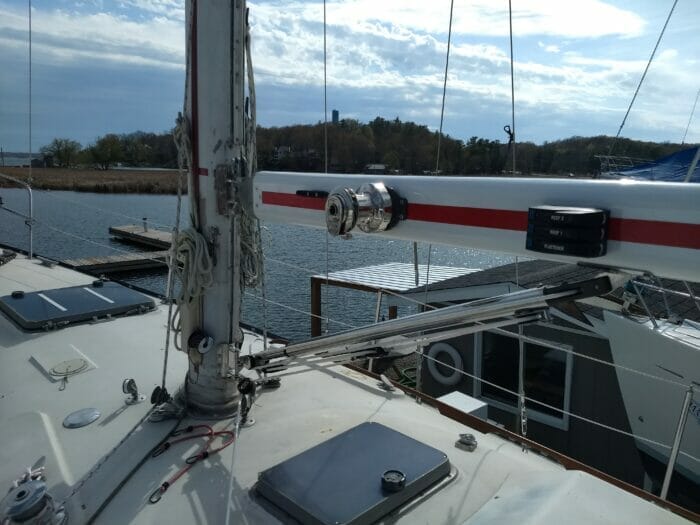
New Main Halyard Winch
After Katy’s first few attempts to get the mainsail up by herself were stymied, we decided to splurge on another Andersen self-tailing winch for the main halyard. Hoisting and dousing sail is now an easy one-person job for either of us.
The Engine
We seem to have chosen well (or been lucky) on this front. The engine, and most of its supporting systems, seems to be in fine shape. So far, all we’ve had to do is change the oil & filter, winterize the raw water side of the cooling system, and tighten a drive belt.
Fun You Can Have With Diesel Fuel
The fuel system was a bit more fun. The surveyor noted that the diesel fill hose wasn’t double-clamped; he didn’t know that it had no hose barbs and was just slipped over a smooth copper tube fitting. Yeah, that was a fun day of cleaning out the bilge with an oil extraction pump…at least now we know that the new hose is done right.
The Wiring
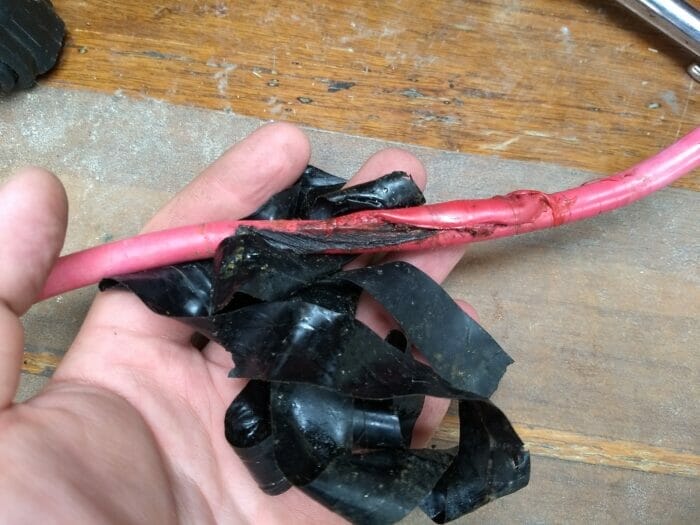
Well, this was a fun thing to find in the bilge:
My best guess is that it chafed against its mate many years ago, and got wrapped in tape as a quick get-home fix, and was then forgotten about.
With that found, and with corrosion spotted on several badly-crimped terminals, the decision was obvious: Rip out and replace all the high-current primary wiring.
The original 12V breakers are getting to be in rough shape, too. We’ve put together a new main panel, and are migrating old circuits to the new panel one at a time as we check and refurbish (or replace) each one.
The nav lights also turned out to be shot. And also shorted…from chafe…inside the bow pulpit tubing. So the whole pulpit is coming off, and we’ll replace the whole wiring run with new marine-grade cable while we’re at it.
While some DC wiring remains to be cleaned up and refreshed, the essentials are now functional, and the spending is mostly done—what’s left is just labour time.
Netting
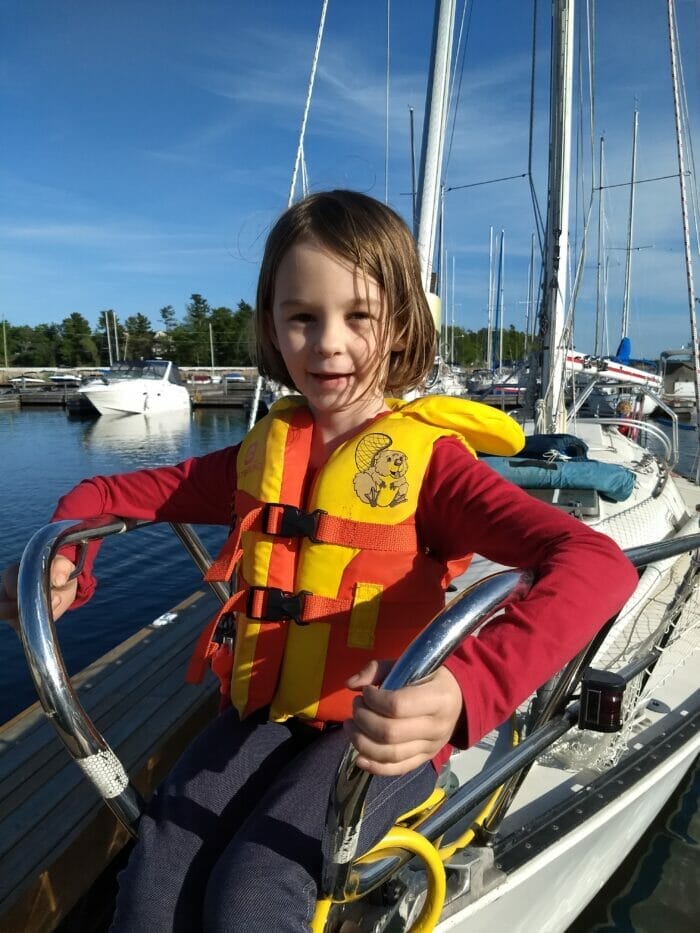
With little kids on board, lifeline netting was also deemed to be a good use of $300 and 16 hours.
The Electronics
Electronic gadgets are a sure way to blow past a refit budget. That said, we really did want a modern, legal VHF-DSC Class D radio with a remote mic to replace the awkwardly placed SC-101 unit.
The Canadian Coast Guard, and the Canadian Power & Sail Squadrons, strongly recommend that a GPS-linked VHF-DSC set is the fastest and best way to get a distress call out, should one ever be needed, or to answer a distress call if you receive one.
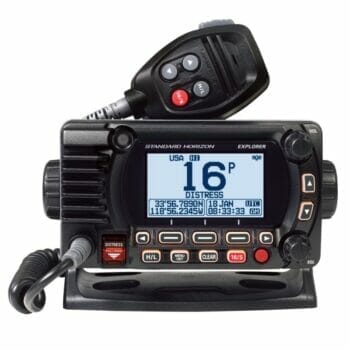
We went with a Standard Horizon GX2400 with a RAM4X remote. This unit has a good integrated GPS and also receives AIS, which it can dump onto the NMEA2000 bus if we ever add one, and can be fully controlled from its wireless mic.
Other than that, we’re sticking with iPads for electronic navigation, and have felt no particular compulsion to upgrade the original knotmeter. A new depthsounder might be in the cards, though, and we will (someday) wire up the half-installed wind instrument the boat came with.
The Structure
Rudder
I was very nervous, when we drilled the rudder blade to check for water, whether we’d find rusty sludge dripping out. But we found…nothing. The core is dry.
Keel
Maverick V did develop a very slight “keel smile” in the forward ten inches of the root joint during her first season with us. This is not hugely surprising. Scraping out the crud, cleaning up the bond line, and repairing it with West System G-Flex seems to have done the trick, and the issue did not recur.
A fresh coat of Interlux VC17 rounded out the hull work.
Cosmetics
Her decks could use repainting, and some of the brightwork needs sanding and varnishing. In her current state, nobody’s going to mistake her for a fancy modern boat. But she’s safe, seaworthy, fun, and serves her “starter cruiser” role very nicely.
The Budget
Spent to Date
We promised we’d give you readers the real numbers for this exercise: no guesswork, no hemming and hawing. So here are the sums. All figures are in Canadian dollars.
- Purchase boat: Target $20,000. Actual $17,500.
- Taxes & fees: Budget $3,000. Actual $2,445.
- Purchasing overhead: Target $2,000. Actual $1,949.
- Essential safety gear: Target $2,000. Actual $2,216.
- Initial refit parts & labour: Target $5,000. Actual $5,104.
- Refit & delivery overhead: Target $2,000. Actual $1,681.
- Refit unknowns in 1st & 2nd year: Target $6,000. Actual $6,844.
All told, we’ve put C$37,738 into:
- The purchase,
- all the taxes and fees associated with it,
- the initial repair and refit,
- the overhead (travel, survey charges, haul & launch, etc.) associated with choosing the boat and getting her to our home port,
- and the remaining refit items we decided on after living with the boat for a year.
That’s right in line with our budget of C$40,000 (US$30,000)
Boat Worth Today
None of the overhead and taxes, and only about half of the refit expenses, would be recouped in the value of the boat.
Indeed, the boat—if we can eyeball it based on current market data—would probably be worth about $24,000 – $26,000 CAD in her post-refit condition. This is as expected. One does not start fixing up an older boat in the hopes of making money on the deal!
With the marina, haul-out crane, and winter storage yard taking a combined $4900/year and the insurer claiming a $600 premium, our CAD$7,000 (US$5200) a year total cost of ownership (TCO) budget leaves about CAD$1500 for the boat itself.
With the repair and refit expenses (if not the labour) nearly complete, the spending should drop considerably for the next few years, so we have a good chance of keeping the entire endeavour within budget over the originally projected five years¹.
¹[See this article for how Matt budgeted TCO (taking into account sale value of the boat) the number that really matters.]
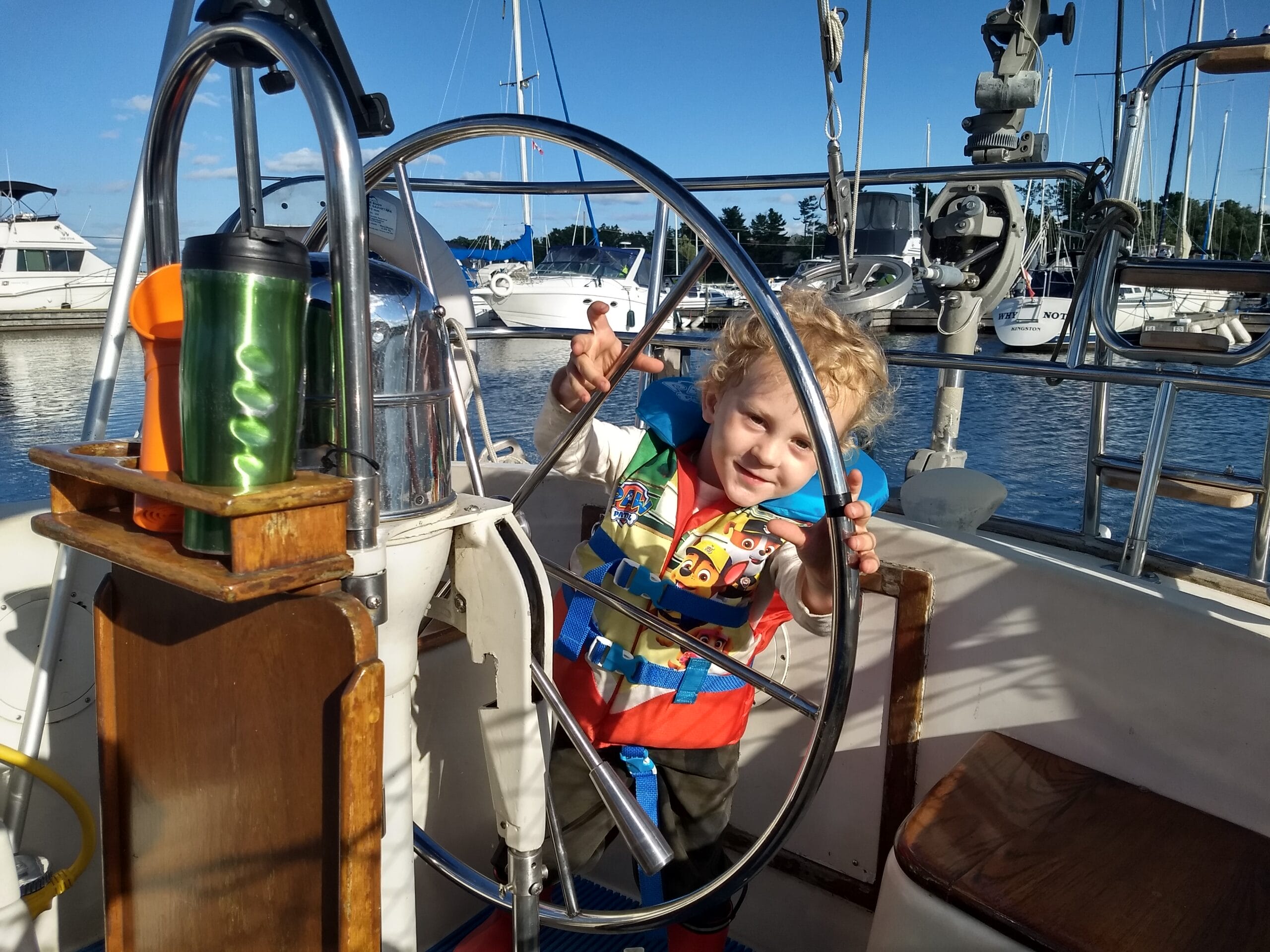
Is Everyone Happy?
Yes! Sailing is, as we all know, a ton of fun. The boat has helped us to reconnect with friends, and with nature. She gives us a chance to slow down, to put the smartphones away, and to enjoy the peace and simplicity of life on the water for a while.
Now that the kids are a bit older (7 and 3), we’ll be able to go farther afield this year. Exploration awaits!
Update February 2024
It’s been a couple of years since this article was written, so for the benefit of those who are considering doing the “starter cruiser” thing, here are the latest figures:
The total expenditure to buy the boat, refit it, operate it, and replace everything that’s broken (including everything previously mentioned plus some hoses, wiring, cushion fabric, and one new sail) for four years has been C$43,100.
In addition to the boat’s own costs, the marina, launch, haul-out, storage, and shorepower fees have totalled C$21,286 over four years. They are, in 2024 dollars, now running C$6,300 a year.
Projecting out to the five-to-seven-year TCO horizon we originally set for our calculations, and assuming the boat’s current market value of C$25,000 holds, our total cost of ownership will come in at about C$3,200/year for the boat itself plus C$6,300/year for the marina slip.
That’s about C$9,500/US$7,100 per year, which is (adjusted for inflation since 2020) about 18% above our original target. The boat itself is not too far from its original budget; the difference is mostly in the recent extreme inflation of marina fees.
In other words, the TCO of a starter cruiser is utterly dominated by docking and storage costs. Provided that you are able to keep those under control (e.g. by keeping the boat in a cheaper area or on a mooring), and do not waste too much money on excessively fancy refit parts or contracted labour, owning such a boat for five to ten years at a comfortable and manageable TCO is, indeed, possible.
And it is a choice that I would definitely recommend to anyone who’s in the same situation we were in when this saga began.
Further Reading
Comments
Leave a comment if you have questions for Matt.
Also, have you managed to put together a viable starter cruiser for under, let’s say, US$50,000? If so, tell us about it including what you had to fix, and what’s left to do.

Hi Matt
Can only thank you for keeping up these articles.
I missed the first 2, believe or not, but ive catch up right now.
Great, great stuff!
I’ve always said that a sail boat is the best money losing investment I’ve ever made. The intangible benefits of all the education, pleasure, mental and physical health derived from owning and sailing a boat are definitely worth the material “losses” from depreciation, wear and tear, and obsolescence that are among the burdens of sailboat ownership.
Hi Reed,
Well put and so true.
Dick Stevenson, s/v Alchemy
Absolutely. As long as the boat’s costs are not unduly burdensome, it makes a lot more sense to focus primarily on the enjoyment of the sport. Never try to calculate an effective cost per trip or per hour of owning a sailboat; that way lies madness.
It looks like you have ended up with a nice boat Matt. Nicely done with setting a realistic budget and staying there.
Our total came to a little bit more at £50000. But this has taken us from Europe to Brazil and onto the Caribbean.
We started with a very well kept Wauquiez Prétorien. That was completely usable for coastal marina hopping with nothing required.
This was for us a significant upgrade from the Jaguar 27(UK Catalina 27) I had a part share in.
As well as a selection of smaller jobs we:
Added an arch and 400W of solar
Doubled the size of the house battery bank. And renewed the main wiring
Upsized the alternator.
New life raft
Inner forestay added and storm jib.
Added a new anchor and 60m of chain (we didn’t think the 10kg (20lb) Bruce would cut it).
Brought a Dinghy.
Updated some of the tired running rigging.
What we didn’t do was change the old autohelm instruments and autopilot and we still don’t feel the need to.
5 years in and we are now planning to pull the mast for a better check than we achieve off the end of a halyard and replace the standing rigging. We are also due a new Genoa, although ongoing repairs to the 2 that came with the boat has kept them functional.
Finding the right boat to start made a huge difference to how much we needed to do. We could almost have just turned the fridge off and left.
Dan, I’m glad to hear it’s working out for you. Your Wauquiez is remarkably similar to our C&C, with almost exactly the same length, displacement, mirrored general arrangement, and capacities, although we fly about 19% more sail and it sounds like your M&E systems are significantly more elaborate.
I see a couple of Pretorien 35s in the US $55k-$63k range right now, so your £50k ($68k USD) total (I assume that figure includes your refits/upgrades?), less the current market value of the boat, puts you at a very reasonable five-year depreciation and TCO.
I think that’s a good example of how choosing the right boat — one that’s well maintained, in generally good shape, and in the flat tail of the depreciation curve — and taking good care of it can keep the total budget affordable.
Great to see a genuinely attainable cruising boat. Great work Matt.
I’m looking to get started with a small boat capable of crossing oceans, I have a $15,000 budget and $65 a week to spend on upkeep and upgrades.
I can make do with an extremely simple boat, no frills whatsoever as I simply wish to experience sailing without distractions.
Is this possible?
Just has to be seaworthy and easily single handed, I would appreciate guidance on how to go about picking out a suitable boat here in the UK
Hi Richard,
I think the combination of ocean ready and those numbers is probably a stretch. Colin and I have looked at this and concluded that about US$100,000 is the number, all in, as soon as we add ocean capable to the mix. The problem is that even if we buy a very inexpensive boat the costs of making her truly ocean capable, since at that price point she will be old, add up quickly. And it’s important to understand that although Matt has kept the costs much lower than that, he has not dug into the stuff required to make his boat ocean capable.
We have a lot more information on all of that here, including some recommended boats to look at: https://www.morganscloud.com/category/refits/
So, my suggestion would be to drop the ocean capable requirement, at least for now and just focus on coastal cruising, in which case you might be able to hit your budget, although the boat will probably be quite small, and require quite a lot of work to get ready for any sort of cruising.
The key thing working for you here is that you are willing to keep the boat super simple, which will certainly help you meet you goal. You may also find, particularly with a smaller boat, that you can source a lot of the required gear second hand.
If you can up your budget a bit, one of these might be a good choice: https://www.yachtworld.com/boats-for-sale/make-sigma/model-33/
If you want a boat in your budget, a Scampi might be a good option. I loved the Scampi when she came out all those years ago however I have no idea how well they were built or what problems they may have 50 years on.
Hi John,
Your recent response to Richard’s question, underlines, for me, one of the really valuable aspects of AAC’s contribution to cruising journalism: a realistic appraisal of the ingredients that makes for a safe platform to go to sea. The closest writing in my early years was the book “Desirable and Undesirable Characteristics of the Offshore Yachts”, probably still worth reading.
My best, Dick Stevenson, s/v Alchemy
Hi Dick,
Thanks for the kind words, and I agree, “Desirable and Undesirable Characteristics of the Offshore Yachts” is a classic and will always be worth a read.
I’ve considered my options within budget and as you say, $100,000 is really the starting point.
So I won’t be getting my own boat but perhaps the better option is to contribute to and join a crew…
Do you know anyone setting up a Bug-Out-Boat in the UK that could take on crew?
As you know the way things are going, having a boat you can sail out thousands of miles from the nearest land and loiter for 6 months or more on carried stores and watermaker is damn good thing, I’ll bring the Jordan series drogue and arrange fitting for the appropriate mounting points for it, as well as emergency Sextant Noon sight navigation.
Hi Richard,
I’m not really the guy to ask since, perhaps unrealistically, I’m not into those sorts of dooms day scenarios, so would not know of anyone getting a boat set up on that premise.
$15k up front and $3380/year operating cost will get you a decent choice of old, simple, 30-foot coastal cruisers. You’ll likely need to be on a mooring (marina fees would eat up most or all of that budget) and to do a fair bit of fixing up yourself, as we did, but it is possible.
Can you take such a boat out on the ocean? Yes.
Should you take such a boat out on the ocean? No.
We’ve managed to keep the cost for Maverick V down by explicitly excluding trans-ocean capability at this time. She is set up nicely for the Great Lakes and coastal cruising, and could handle island-hopping in the Lesser Antilles (indeed, she appears to have spent three years doing just that under a previous owner), but is nowhere near ready to cross the Atlantic.
I’m working on the figures for what it’d take to bring her up to a safe offshore standard, just as an exercise (we don’t actually intend to do so). The short version is that, by the time Nova Scotia falls over the western horizon, we’d have spent another $30k on materials and equipment, plus around a thousand hours of labour, bringing the total expenditure of time and money to somewhere within a stone’s throw of $100k. And we would not have significantly improved the resale value, or the insurance value, of the boat…. so that’s all expense, with no asset to show for it.
You can do a *lot* of coastal cruising in the UK and along the European shorelines without needing trans-ocean capability. And you can always crew on someone else’s boat for a few weeks if you really want to get your bluewater fix in.
Matt – Great articles and I appreciate your description of Maverick V’s capabilities, it perfectly describes “the mission” for our first cruising boat – my wife and I are experienced Lightning racers but have limited cruising experience. I have two questions: First, can you point me to resources for determining TCO, we’re currently looking at boats in the $50-100k range with a TCO budget of ~$20k/yr but not sure if I’m calculating that correctly. Second, we’ve been searching for the past 9 months (made offers on two boats – Ericson 38-200 and Morgan 382) and would like input on boat designs/models that fit the budget and intended use. We expect to keep the boat on the coast of Maine and are hoping to find something with a nice mix of comfort (underway and at anchor) and performance, even though we don’t intend to race.
There’s no good definitive guide for predicting TCO.
You can get accurate pricing for dockage, launch, haul-out, and winter storage from your local marinas. Those will be a mix of per-foot and per-season costs. If you are projecting over multiple years, bump them up annually by the average rate of inflation if you’re in an economically stagnant area, or by 1.5x annual inflation if you’re in a high-growth urban area.
You can use some first-approximation rules of thumb for the rest, at the initial “is this feasible?” stage, until you’re ready to do a more detailed budget:
Annual maintenance (mainly DIY except for specialty trades), for a boat more than five years old, that starts out in good seaworthy condition, and is to be kept in that condition, can be estimated as 5% of the purchase price of a fibreglass, aluminum, or wood-epoxy boat, 7% for a steel one, or 10% for a traditional wood one. Add 5 percentage points to each of those if you are contracting out all the work; deduct two if you’re good at scavenging for deals and don’t mind some downtime waiting for parts (rather than just paying chandlery list price for local stock).
Annual insurance for cruising inland or within 100 miles of shore can be estimated as 2.5% of the purchase price, give or take 0.5.
Depreciation is really hard to predict. If it’s a production boat that was built over some period of time, you can use Yachtworld to get an idea of the spread of values and whether there’s any trend with year. Eg. if you see similar boats at $400k for a 2019, $350k for a 2017, $300k for a 2014, and $250k for a 2010, that’s a pretty good data set to draw on. Likewise, if you see a 1993, a 1997, and a 2004 in similar condition and they’re all between $100k and $140k, then that model’s probably at the tail of the curve where condition and maintenance matter more than age.
Refit costs are also hard to predict. If there’s a spread in prices between similar boats, then the parts and labour cost of getting the cheapest one up to the same standards as the best one will typically be two to three times the difference in listed sale prices between them. Getting an accurate projection for a given boat really comes down to knowing how to identify and fix everything that appears to be wrong, adding up the parts, taxes, and labour…. and then doubling it.
Be conservative on all of your predictions. Many a dream has died because the $20k/yr budget got stretched to $22k, then $25k, then $30k, and all of a sudden a line of credit ends up in arrears and the boat’s listed as “Urgent Sale”.
Hi Ben,
In addition to Matt’s great comment, you can also find our maintenance calculator here: https://www.morganscloud.com/2014/07/28/estimating-the-cost-of-maintaining-a-voyaging-sailboat/
Hi Matt and John,
I get variations of the: how much will it cost?, will it work out financially?, how much do you spend?, question quite frequently.
My answer is that it is quite likely that if you handled successfully your land-based financial life, that you will likely do so in your boat-based life. That if you used good judgment in your land-based life that you will continue to do so on the water. Put another way: it is more a matter of character than it is the amount of money at your disposal.
So, I suspect someone with good judgment will collect data on TCO such as has been suggested and weave that in with all the other variables to come up with something that works.
My best, Dick Stevenson, s/v Alchemy
Hi Matt,
Good points all.
We spent many years sailing Europe, the last 5-6 were in Northern Europe. One of the best things about it was that it was mostly “coastal cruising” while also holding the opportunity of challenging cruising*, wonderful destinations, great history English spoken most everywhere, and great people and their culture.
One season we left London and went to 11 countries before returning to London 7 months later. And during that time, we only did 4 overnights: and 3 were wonderful sails because we did not leave until we had a good forecast. The other overnight was a surprise as Russia was doing war exercises off Poland and kicked us way out to the middle of the Baltic.
My best, Dick Stevenson
*While in the UK, at one point, I was standing next to someone who had recently done a world circumnavigation and another skipper who had just circled the UK. The UK cn’er was being admiring of the feat of the world cn’er and I commented that the UK cn’er had perhaps met more seamanship challenges: navigation, weather changes, tidal and current obstacles, high wind, etc. than the world cn’er had bumped into in his travels. The world cn’er, a seasoned UK sailor, readily agreed saying there was little comparison. He said the UK sailing prepared him well but that the cn was, by and largely, a wonderful milk run.
Hi Richard
So it seems from the comments below that you aren’t going to make it with a 30 footer. But if you are serious about extremely simple and no frills how about going down 4 or 5 more feet and look for something like a Contessa 26 or a Folkboat ? Definitely ocean capable in the right condition.
Of course it helps if you are not too large or old. I went to the Azores and back to UK in a Folkboat in my early twenties and had a fantastic time. I would have gone further if the Stuart Turner petrol engine had worked slightly more often and if I hadn’t met my future wife in Horta. She was almost as tall as me and strongly suggested an upgrade.
Not all the boats for sale in this price range are listed on Yachtworld. Many are on the sell your own sites like apolloduck.co.uk. There’s a somewhat battered grp Folksong on ebay at the moment with the current bid at £10.50.
If you are patient something will come along which someone has already done most of the work on. New engine and rigging for preference.
Best
Mark
Hi Mark,
Great idea. I once met a single hander sailing a Folkboat and having a wonderful time…in Greenland. As long as you are tough, and probably relatively young, amazing voyages can be made in very small boats. Some can even substitute super-tough for young, like Willy Ker who regularly cruised the Arctic in his Contessa 32 well into his 80s.
that’s an awesome story! Do you have any pictures or writing from the trip? Sounds wonderful. +1 to the yachtworld issue. I would go so far as to say that likely none of the suitable boats will be on there. However I did save listings I liked and waited for them to expire without a sale. Then reached out to the broker, with excellent results. Other good sources are Marinas and yards, find out what lawyer they use for selling off ones with unpaid bills especially and reach out to them too. I scored a Columbia 43 for someone this way, offshore veteran complete with a Cape Horn watermaker and all sorts of goodies for about 2400 pounds(4100$). Do this early, and then in the 6 weeks before moorage will be due for the year make your rounds again. Go to yards and marinas, explain what you’re looking for and have some business cards with your name and number on them. It’s amazing how many calls you’ll get over time this way. Often you can find true gems, where the owners health took a turn and a nicely fitted out boat that needs neglect reversed and a good bath will go for pennies compared to the same boat cleaned up on yachtworld. Often the first place they stop is their marina office and they mention they are wanting to sell her on, at which point the cards you have spread around come in handy.
Funny you mention folksong, I was actually looking at a 1967 wooden Nordic folkboat actually named folksong because she is right next to me: https://folkboats.co.uk/2023/09/28/nordic-folkboat-folksong-4950/
Not too sure about the state of the keel though, looks like she’s taken a grounding and exposed the steel ballast if that’s what it looks like in these photos I took:
https://imgur.com/a/pvFYaz7
Not to sure about the state of the hull either, but was worth a visit because she’s just a 20 minute bike ride away.
I was actually just starting my refit with similar goals, I haven’t documented much yet, and with a serious injury putting me off work(and walking) for the season not much will be happening. However I think I am still on target for 50k CAD ready to go offshore, with adequate spares on board, though that would require a captain experienced enough to do it, which I am not. That number will be without some of the nice-to-haves like a watermaker(unless somebody here has a energy recovery one that has failed, I have some ideas I want to try out, don’t mind the state of the unit and none of the feed pumps will be reused, all I care about is the ER unit being rebuildable for these tests, if they prove successful it may be a way to economically build reliable efficient watermakers for less. I am not counting moorage costs, because it is also normally my home for about 1/3 the cost per month of a studio apartment. Though a lot depends on material price changes between now and when I can get back at it. This is for a 33′ steel cutter, well fitted out for offshore use but tired. Somewhat like the Adventure 40, they were a small builder that specialized in the same niche you are going for with the A40, and this one’s interior was a custom layout that mirrors many of your choices. I am giving serious consideration to replacing the nav station with a shower based on your discussions here. I could post the original line drawings and design brief from the manufacturer if you’d like? The original factory layout was entirely different, and I doubt I’d have bought her with such. They no longer build these, and haven’t for decades as they found by going to a 36′ they could charge far more for relatively low increase in labour.
The big 3 for variables on cost are sails, electronics(do I go open source or name brand?) and whatever hull repairs are needed once we strip the paint above the waterline(below was blasted to bare metal and coated to original specs again). As a bonus, the brother in law of the previous owner owns the company that built her, so I am lucky to be able to ask questions and get specifications for paint systems etc.
I’ve been lucky with many bits so far, for example, I found a drop in replacement for my well cared for but aging Yanmar 3GM30F, a 3 cylinder 3JH including mounts and transmission with <200 hours for about 2500$ CAD delivered.
For a steel boat, your depreciation (and therefore your total cost of ownership) is utterly and completely dependent on rust, and therefore on maintenance. Reviewing Colin’s “Why Not Steel?” articles would be wise, if you haven’t already done so.
In short, if you want a steel boat to be cost-effective and stay on budget, you absolutely must take very good care of her hull and structure, and use high quality coatings and rust protectants throughout. This is expensive. But the only alternative is for the boat to slowly disintegrate underneath you, which is even more expensive.
For sails, I feel like unless one has a particularly sporty and close-winded boat, the point of diminishing returns is hit somewhere between cross-cut and radial-cut heavy duty Dacron cruising sails. The cost and longevity of anything fancier than that just doesn’t work out for someone on a tight budget.
As for electronics, if funds are limited, I generally recommend you carefully consider what the safe minimum fit-out is for your purposes, and then choose high quality commercial gear for what you do need. A boat with just a depthsounder, radio, AIS transponder, and chartplotter — but all of those being from the likes of Furuno or Icom — is much easier and cheaper to live with, long term, than one whose sounder, speed/log, wind instrument, tank monitors, radar, fishfinder, AIS, recording barometer, sea temperature sensor, engine instruments, etc. are each bought from the cheapest recreational supplier and patched onto a whole-boat network.
It’s been a couple of years since this update, so for the benefit of those who are considering doing the “starter cruiser” thing, here are the latest figures:
The total expenditure to buy the boat, refit it, operate it, and replace everything that’s broken (including everything previosuly mentioned plus some hoses, wiring, cushion fabric, and one new sail) for four years has been C$43,100.
In addition to the boat’s own costs, the marina, launch, haul-out, storage, and shorepower fees have totalled C$21,286 over four years. They are, in 2024 dollars, now running C$6,300 a year.
Projecting out to the five-to-seven-year TCO horizon we originally set for our calculations, and assuming the boat’s current market value of C$25,000 holds, our total cost of ownership will come in at about C$3,200/year for the boat itself plus C$6,300/year for the marina slip.
That’s about C$9,500 / US$7,100 per year, which is (adjusted for inflation since 2020) about 18% above our original target. The boat itself is not too far from its original budget; the difference is mostly in the recent extreme inflation of marina fees.
In other words, the TCO of a starter cruiser is utterly dominated by docking and storage costs. Provided that you are able to keep those under control (eg. by keeping the boat in a cheaper area or on a mooring), and do not waste too much money on excessively fancy refit parts or contracted labour, owning such a boat for five to ten years at a comfortable and manageable TCO is, indeed, possible.
And it is a choice that I would *definitely* recommend to anyone who’s in the same situation we were in when this saga began.
Hi Matt,
Great stuff, I will add that to the main post in an update box.
This is a very useful article. Thank you Matt.
Interesting that the berthing haul out and storage cost amount to the largest part of the annual budget.
I hope you don’t mind but I am going to use it now as a template for my own potential purchase in the near future. It will be around the same length, plus or minus a couple of feet or so.
Thanks again for taking the time to write about your experiences in getting sailing.
Viv
Hi Matt,
Really appreciated this series, and your clear, concise engineer’s thought process! As a father of a 2-year old, with another on the way, and with a similarly sized boat sailing in San Francisco, here’s a request for an article on tips for sailing and cruising with young children!
Fair winds,
Adam